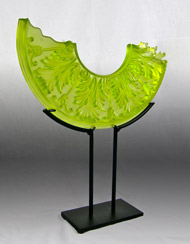About: The Medallions
Full versus Pale Colors
A number of colors offered, particularly in the blues and greens have pale versions. These are essentially a tint of the full-bodied colors. When a lighter, brighter, more translucent or subtle look is desired, the pales should be considered. When a deeper, more opaque-like (for wall mounting, as example) or striking effect is sought, the full colors might be preferred.
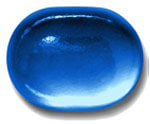
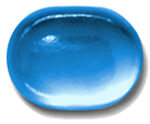
Black Crystal
Black crystal is completely opaque, and closely resembles obsidian, a natural black volcanic glass. Some have also compared it to black Wedgewood, black granite, or black onyx. Medallions cast in black crystal will be highly dramatic, and transmit no light. They will be extremely imposing sculptures.

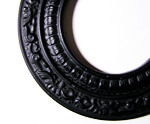
White Glass
The singular glass used for the medallions that is not lead crystal is the White, which is sodium carbonate/limestone based, rather than lead oxide based. The reason for this is that this particular glass produces a consistently dense white, similar to a pure white marble. Like Black crystal, it is completely opaque and will transmit no light. Those desiring a sculpture that more resembles the fine white marble utilized in classic statuary might consider this selection.
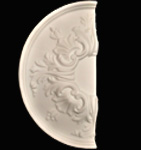
Clear Crystal
Originally water-clear, the final sand/acid-etching treatment to the clear glass imparts a satin-frost finish to the surface. The end result is a soft, Lalique-like appearance to the crystal. Although this process is performed on all medallions, the transformation from transparency to diffused translucency is most pronounced with the clear crystal. The effect is so pronounced that the medallion, depending on lighting, can almost appear to take on a whitish tint, as demonstrated by the photo on the right.
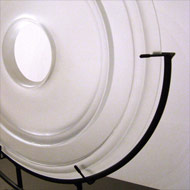
Striker Colors
There are two colors offered that are considered “strikers”. They are Ruby and Amethyst , and these two glasses, which are nearly colorless in their raw state, do not attain their final color until fired. The heat work of the kiln is responsible for promoting the maturation of the final color. If these colors were struck in the manufacturing process, they would become “overstruck” under the extra heating regime of casting. Both of these glasses contain actual Gold, and require a certain viscosity in order to cause the metal atoms to form a colloid and a certain particle size in order to transmit the ideal color.
Dichroic Glass
There are five colors offered, indicated with an asterisk on the color chart, that are called “dichroic”. This term is more commonly used to indicate art glass with a high-tech metallic coating which transmits a different color than it’s reflected one when viewed from different angles. In the case of Gaffer® crystal, the term refers to glasses possessing a special characteristic of shifting color depending on type of lighting. Under daylight, incandescent, or LED light, they transmit their true color. However, under fluorescent light, they display a completely different color.

Hyancith under daylight, incandescent, or LED lighting
When fluorescent lighting was largely confined to basements, garages and workshops, this characteristic was not so much an issue. However, energy-efficient compact fluorescent bulbs designed for living areas were introduced, and were briefly popular. These lamps soon declined in sales in favor of the superior LED bulb. For those who currently have CFL’s, this color-shifting quality is considered desirable and exciting by some with this type of lighting, because their sculpture is one color by day and a completely different one when the lights come on. However, it is a phenomenon that should clearly be understood and anticipated by the client when choosing color. Shift under fluorescent light is as follows: Rhubarb shifts to green; Semillion shifts to green; Lilac shifts to blue; Hyacinth shifts to blue; Purple shifts to blue.
Riser Height of Table Displays
The height of the risers (steel rods connecting the harp to the base) on the table displays is inversely proportionate to the diameter of the medallions, i.e. as the diameter increase, the riser heights decrease. The combination of display height and medallion diameter can be used to predetermine the sculptures total height. This can be an advantage if the sculpture is earmarked for a specific location, such as a niche, shelving or any spot where height constraints might be an issue. These are preselected heights, chosen to keep the total height of the sculpture between approx. 16″ and 26″. Note: the combined weight of the medallion and its steel display can exceed 50 pounds, so please consider that when deciding its location.
*Only available with the Fragment’s own petite table display with split harp (single base plate, demi-harp).
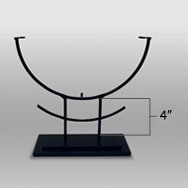
Medallion diameter
- 16″ fragment*
- 16″–17″ diameter
- 18″–22″ diameter
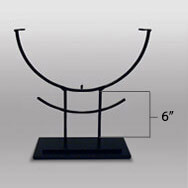
Riser height
- 8″ risers
- 6″ risers
- 4″ risers
Wall Displays
Wall harps should always be screwed directly into a wood stud, or securely fastened with the properly rated molybolts. Since the medallions are quite heavy, adequate precautions should be exercised when mounting on vertical surfaces.
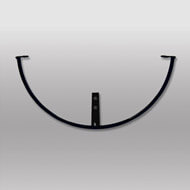
Floor Displays
Floor displays are available for a surcharge, and are available in two styles. Heights with medallions are approximately five feet tall. These substantial stands utilize riser rods that are ½” in diameter instead of the 3/8″ diameter rods used in the table displays, and their bases are 10″ wide, versus the 6″ width of the table bases (with the exception of the 16″ fragment base, which is 4″ wide).
The floor displays are quite stable, with one caveat. Because these pieces are inherently top heavy, it is strongly suggested that they be placed only in rooms with a concrete floor or subfloor (such as rooms built on a slab or apartment/ commercial buildings with concrete floors). When placed on a wood floor or subfloor, vibrations from foot traffic can travel up the risers and cause the medallion to sway slightly.
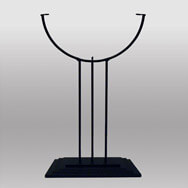
Care of Your Sculpture
Your sculpture only requires an occasional feather dusting. The acid etched finish makes the surface quite resistant to fingerprints, and any deposits can be removed with a soft cloth dampened with either water or glass cleaner. Please note that when the crystal becomes moistened, it will briefly turn transparent, but will return to its satin translucency when dry. The powder-coat on the steel is extremely durable, but any nick or scratch can be easily remedied with a black Sharpie.
ENJOY!
